As the trend towards sustainable and low-maintenance landscaping grows, many homeowners and businesses turn to artificial turf as an alternative to natural grass. With its promise of lush greenery all year round and minimal upkeep requirements, artificial grass has become a popular choice for outdoor spaces.
In this guide, we will talk about the safety aspects of artificial turf, addressing common concerns and providing evidence-backed insights to help you make an informed decision for your space. We’ll also debunk myths surrounding its safety, highlight its environmental benefits, and offer practical tips for selecting the right product.
The Composition of Artificial Turf
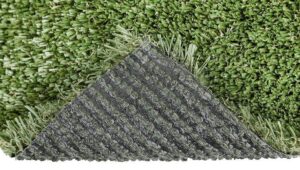
Artificial turf, also known as synthetic grass or fake grass, is crafted from a blend of synthetic materials designed to mimic the look and feel of natural grass. These materials typically include polyethylene, polypropylene, and nylon, each chosen for durability, resilience, and aesthetic appeal. Artificial turf has high adaptability as well, going hand-in-hand with popular pool decking options, soccer fields, and front lawns alike.
Unlike natural grass, which may require chemical treatments to maintain its lush appearance, artificial grass eliminates the need for pesticides, herbicides, and fertilizers, contributing to a safer and more eco-friendly outdoor environment.
Contact an Expert
The Role of Infill in Artificial Turf
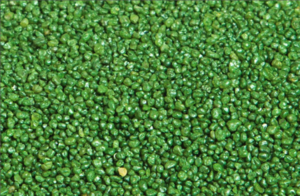
Infill is a crucial component of artificial turf systems, providing stability, cushioning, and drainage capabilities. Traditionally, crumb rubber infill, made from recycled tires, was widely used in artificial turf installations.
Today, homeowners and landscape professionals can access various infill options, including Hydrochill, Durafill, and organic materials like cork and coconut husks. Choosing non-toxic infill materials ensures a safer and more enjoyable outdoor experience for your family and pets.
Safety Features of Modern Artificial Turf
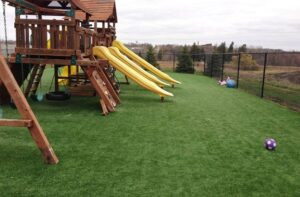
Advancements in artificial turf technology have led to the development of innovative safety features designed to enhance durability, performance, and user comfort. High-quality artificial turf products now incorporate UV stabilizers to prevent fading and degradation caused by prolonged sun exposure. Additionally, many manufacturers offer lead-free alternatives to address concerns about heavy metal exposure, especially in areas frequented by children and pets.
Some artificial turf varieties also boast anti-microbial properties, inhibiting the growth of bacteria and fungi that can compromise hygiene and safety. When combined with proper installation and maintenance practices, these safety features ensure that artificial turf remains a reliable and long-lasting solution for outdoor landscapes.
A Safe Choice for Children and Pets

For families with children and pets, the safety of outdoor play spaces is a top priority. Artificial turf offers several advantages over natural grass, including reduced exposure to allergens, pesticides, and fertilizers. By eliminating the need for chemical treatments, artificial turf creates a cleaner and healthier environment for recreational activities.
Many testimonials from satisfied users further attest to the positive impact of our pet turf and playground turf. With proper installation and routine maintenance, artificial turf can provide a safe and enjoyable outdoor surface for all family members to enjoy year-round.
Choosing the Right Artificial Turf for Your Needs
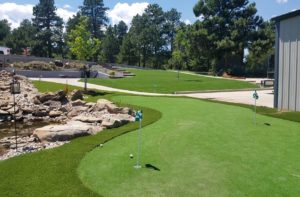
Selecting the best decking material or appropriate artificial turf for your space requires carefully considering various factors, including aesthetic preferences, intended use, safety concerns, and cost. For a detailed understanding of what to expect in terms of investment, refer to our comprehensive artificial turf pricing guide.
Consumers should look for reputable suppliers that prioritize quality control and product safety. Certifications from the Synthetic Turf Council (STC) and the International Play Equipment Manufacturers Association (IPEMA) can be valuable indicators of product reliability and compliance with industry standards.
Additionally, inquire about the testing protocols used to evaluate the safety of artificial turf products, including assessments for heavy metals, toxins, and allergens. You can confidently invest in artificial turf that meets your safety and performance requirements by conducting thorough research and asking the right questions.
Promoting Environmental Responsibility with Artificial Turf
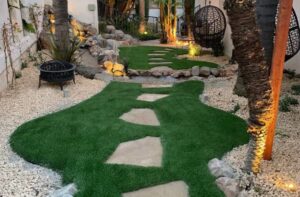
Now that we’ve established that turf is safe, it also offers significant environmental benefits compared to traditional landscaping methods. Artificial turf embodies sustainability principles and environmental responsibility by reducing water consumption, minimizing chemical usage, and promoting recycling.
1. Conserving Water with Artificial Turf
One of the most compelling arguments favoring artificial turf is its water-saving potential. Artificial turf stays green and lush without needing the regular watering that real grass demands. This conserves valuable freshwater resources and reduces the strain on municipal water supplies, particularly in regions prone to droughts and water shortages.
2. Minimizing Chemical Dependency
Another environmental advantage of artificial turf lies in its minimal chemical dependency. Artificial turf doesn’t need the pesticides, herbicides, and fertilizers that natural grass requires, as it’s naturally pest and disease-resistant. This eliminates the need for harmful chemicals that can leach into the soil, contaminate groundwater, and pose risks to human health and wildlife.
3. Recycling Waste Materials
Artificial turf is also an example of resourceful recycling, as it utilizes recycled rubber and other materials in its construction. Recycled rubber from tires, for example, is commonly used as infill material in artificial turf installations, providing cushioning and shock absorption for sports fields and playground surfaces. Artificial turf helps the environment by using waste materials that would otherwise clutter landfills and reduce the impact of tire disposal.
4. Reducing Carbon Footprint
Producing artificial turf uses fewer resources and creates fewer greenhouse gas emissions than growing and maintaining natural grass. With advancements in sustainable manufacturing practices and the use of recycled materials, the carbon footprint of artificial turf continues to diminish, making it an increasingly attractive option for environmentally conscious consumers.
5. Supporting Athletic Performance and Safety
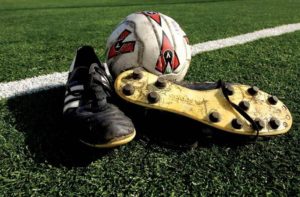
Beyond its environmental benefits, artificial turf offers practical advantages for athletes and sports enthusiasts. The consistent surface of artificial turf, with its uniform grass blades and shock-absorbing infill, provides an ideal playing field for soccer players, football teams, and other sports. Artificial turf can, therefore, enhance safety and reduce the risk of injuries during athletic competitions and recreational activities.
Choosing Flooring Inc. for Your Artificial Turf Needs
At Flooring Inc., we understand the importance of creating safe and sustainable outdoor environments that enhance your quality of life. With our extensive selection of high-quality artificial turf products backed by industry-leading warranties and certifications, we assure homeowners and businesses of safety, durability, and performance.
Whether you want to revitalize your backyard, create a pet-friendly play area, or upgrade your sports facility, we provide expert guidance and exceptional service at every step. Trust Flooring Inc. to transform your outdoor space into a haven of beauty, comfort, and environmental responsibility.
Shop Now
The post Is Artificial Turf Safe for Your Space? appeared first on Flooring Inc..
www.flooringinc.com










